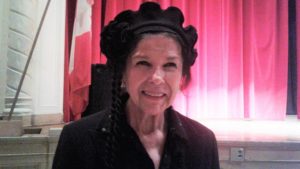Elder filmmaker sheds new hope on education for youth

By Kristin Grant
Prolific Abenaki filmmaker Alanis Obomsawin’s latest documentary, “Our People Will Be Healed”, shows Ontario schools as a prime example of how they can help improve education for our youth. An officer of the Order of Canada, 85-year-old Obomsawin, has made 50 films for the National Film Board of Canada during her distinguished career, mainly focusing on First Nations issues.
Her new documentary focuses on the revolutionary Helen Betty Osborne Ininew Education Resource Centre. This Manitoba school is leading the way in keeping First Nations traditions and language alive. The school creates an inclusive community, quite a beautiful concept considering its predecessor was a residential school.
If the school’s namesake Helen Betty Osborne sounds familiar, it is because she is one of the Missing and Murdered Indigenous Women. Her November 1971 murder was the subject of a book and CBC mini-series called, “Conspiracy of Silence”. The school is located in her home town of Norway House, Manitoba, a Cree community of 5,000 people on the northern point of Lake Winnipeg.
Obomsawin was recently in Toronto for a screening of her film and a Question & Answer period. During the question period, she discussed the changes to the education system. How now people are asking “what are we going to do to make it better? How are we going to encourage the people more to learn the language? Our language now is respected, before we were punished for speaking it at the school level. So just that alone is very different now.”
The film shows footage of young students undergoing Cree language instruction.
Given the film’s subject matter, it was quite fitting that the event was held at the Aboriginal Education Centre. According to the Toronto District School Board, the school’s goal is to close “the opportunity gap for Aboriginal students. This mandate is approached by infusing Aboriginal perspectives across the curriculum for all students.”
This is evident from the signs in the hall depicting the Seven Grandfather Teachings and Indigenous student art.
Obomsawin is optimistic for the future.
“It is fantastic, I see where we are going. It is a big change and the respect for our people is so high and people are finding out they can’t believe this is the history.”
The changes aren’t just out west, but everywhere she explains.
“I’m very impressed with, really, what is happening in Ontario. I’ve been invited to many, many things, and you can feel the teachers, they really want to know, and want to apply new curriculum and include the different nations of different provinces.”
The government-funded Osborne school also recognizes the importance of making sure our youth stay in school. The documentary talks about how the school would see a tremendous drop off of students between Grade 9 and Grade 12. One of the contributing factors to this was teenagers getting up early. By adding a second bus run and shifting the start of school an hour later for those students, they’ve seen marked improvement on their graduation rates. It also has the added perk if younger kids miss the first bus they can take the second one rather than miss a day of school.
The school demonstrates not just cultural inclusiveness but for those with disabilities as well.
“A child that is autistic is in the same class with all the other children,” Obomsawin explains. “It makes you feel strong and less frightened of the future, and what is possible.”
The film also delves into overall resurgences of traditional like the sun-dance in the Norway House community.
The documentary, “Our People Will Be Healed”, was part of the 2017 Toronto International Film Festival (TIFF) and named one of their top 10 Canadian Films of that year. It was made through the National Film Board of Canada, but isn’t available for viewing on their website at this time, but some of Obomsawin’s other work is.
Hopefully more educators and administrators will see this film and be able to follow the example to help our language, traditional knowledge and culture flourish among our youth.


